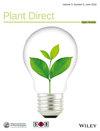以 PINOID 为中心的基因相互作用在子叶形成过程中介导了植物生长素的作用
IF 2.3
3区 生物学
Q2 PLANT SCIENCES
引用次数: 0
摘要
摘要 叶绿素通过叶绿素的局部合成、极性运输和叶绿素信号转导在植物生长发育过程中起着关键作用。之前关于拟南芥的许多报道发现,各类与叶绿素相关的基因参与了子叶的发育,包括子叶的数量、对称性和形态。然而,辅助素参与子叶形成的分子机制仍有待阐明。研究发现,编码定位于质膜的丝氨酸/苏氨酸激酶的 PID 可使 PIN1 蛋白磷酸化,并调节其在细胞中的极性分布。pid 功能缺失会导致子叶数量异常和花序缺陷。有趣的是,pid 突变体与各种类型的突变体协同作用,产生了无子叶的严重发育缺陷。研究表明,PID和这些基因与子叶的形成密切相关。本综述讨论了以 PID 为中心的遗传相互作用、相关基因的功能以及相应的可能途径,从一个角度说明了 PID 及其共调控因子通过多种途径控制子叶的形成。本文章由计算机程序翻译,如有差异,请以英文原文为准。
PINOID‐centered genetic interactions mediate auxin action in cotyledon formation
Abstract Auxin plays a key role in plant growth and development through auxin local synthesis, polar transport, and auxin signaling. Many previous reports on Arabidopsis have found that various types of auxin‐related genes are involved in the development of the cotyledon, including the number, symmetry, and morphology of the cotyledon. However, the molecular mechanism by which auxin is involved in cotyledon formation remains to be elucidated. PID, which encodes a serine/threonine kinase localized to the plasma membrane, has been found to phosphorylate the PIN1 protein and regulate its polar distribution in the cell. The loss of function of pid resulted in an abnormal number of cotyledons and defects in inflorescence. It was interesting that the pid mutant interacted synergistically with various types of mutant to generate the severe developmental defect without cotyledon. PID and these genes were indicated to be strongly correlated with cotyledon formation. In this review, PID‐centered genetic interactions, related gene functions, and corresponding possible pathways are discussed, providing a perspective that PID and its co‐regulators control cotyledon formation through multiple pathways.
求助全文
通过发布文献求助,成功后即可免费获取论文全文。
去求助
来源期刊

Plant Direct
Environmental Science-Ecology
CiteScore
5.00
自引率
3.30%
发文量
101
审稿时长
14 weeks
期刊介绍:
Plant Direct is a monthly, sound science journal for the plant sciences that gives prompt and equal consideration to papers reporting work dealing with a variety of subjects. Topics include but are not limited to genetics, biochemistry, development, cell biology, biotic stress, abiotic stress, genomics, phenomics, bioinformatics, physiology, molecular biology, and evolution. A collaborative journal launched by the American Society of Plant Biologists, the Society for Experimental Biology and Wiley, Plant Direct publishes papers submitted directly to the journal as well as those referred from a select group of the societies’ journals.
 求助内容:
求助内容: 应助结果提醒方式:
应助结果提醒方式:


